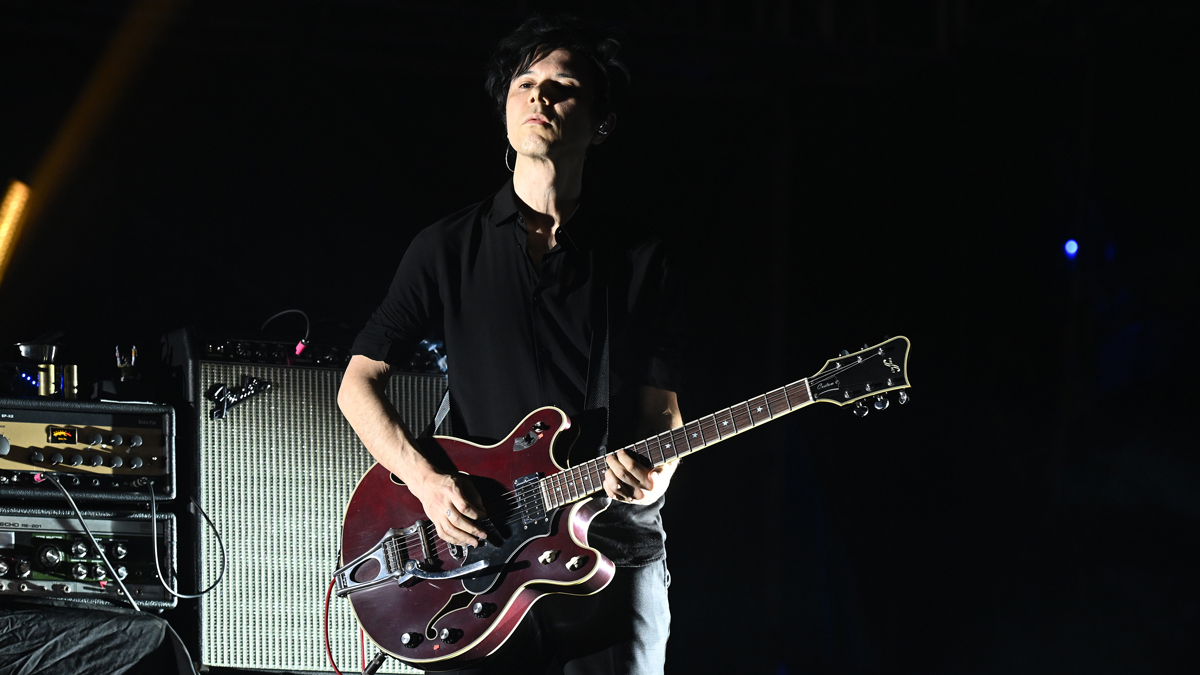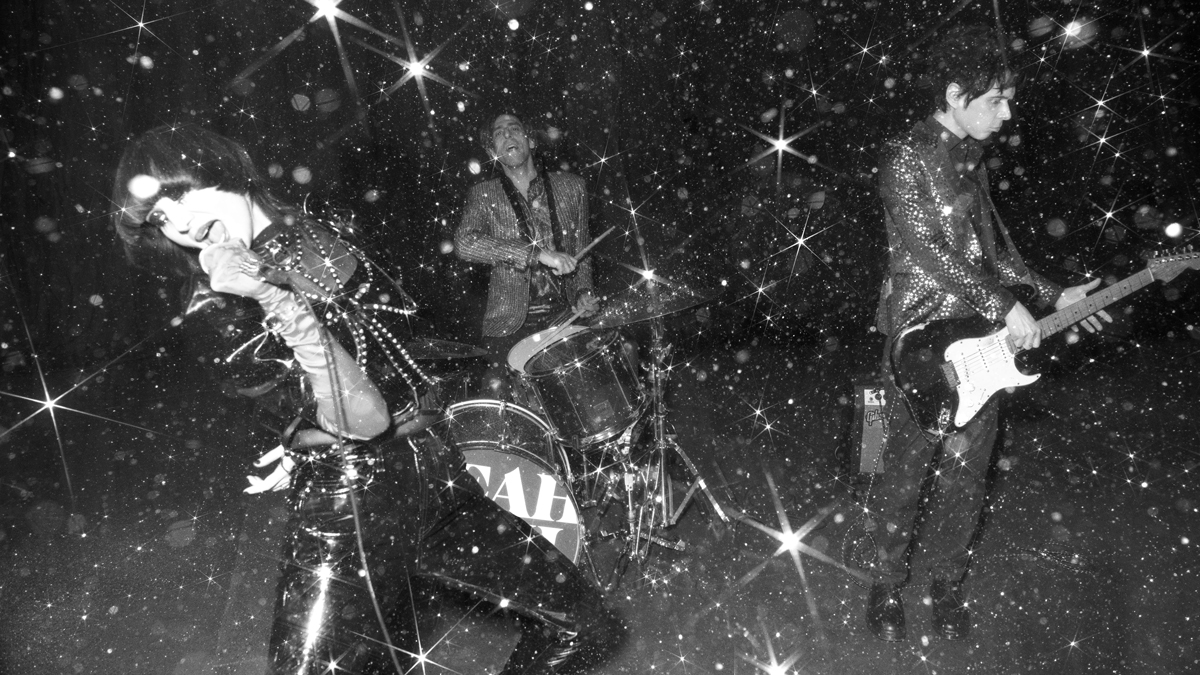Nick Zinner on the return of Yeah Yeah Yeahs: ditching amps, embracing EBow and his early love of Eddie Van Halen
The NYC garage-punk institution are back on grand, sweeping form with Cool It Down, their first album in nearly a decade – although their guitarist is still keeping his metal chops up with a thrash side-project or two…

A nearly 10-year gap sits between Yeah Yeah Yeahs’ Mosquito full-length from 2013 and their brand-new Cool It Down, so the first thing fans will notice is… well… the much-loved trio are back!
Through early album teases Spitting Off the Edge of the World and Burning, fans also might have noticed that the scrappily streamlined sound of early Yeah Yeah Yeahs has become plusher and more immersive – both singles are wide-scope anthems blanketed in either opal swathes of synth or symphonic string production. As the band’s resident guitarist, Nick Zinner is keenly aware of the more supportive and nuanced role his six-string plays on Cool It Down, too.
“It’s not a super-direct guitar record to talk about,” Zinner confesses, but maybe he’s a little too humble on this point.
While the record slathers the senses-stirring buzz of synthesizers into its most jubilant pop-bangers [Wolf] or seems more prone to ride slyly on a flatwound bass groove [Fleez], the rare moments where Zinner fully flexes his guitar style nevertheless hit hard.
Bringing it back to Burning, Zinner delivers a momentary, yet brilliantly vicious piece of fuzz-warped soul guitar to the piece. On Spitting Off the Edge of the World, he revels in the warm-tone weirdness of a multi-layered EBow harmony – a first in the studio for Zinner, he explains to Guitar World, but a technique the musician returns to on Cool It Down’s equally enigmatic Blacktop. This is all to say that more than 20-years on from the group’s self-titled debut EP, Cool It Down is a bold new wave for the group.
Beyond his work with Yeah Yeah Yeahs, the past decade has seen Zinner experimenting with his tone through a number of other projects – some arguably informing the feel of Cool It Down. Its lush atmospherics could be pulling from his more experimental film score work for last year’s Knives and Skin; Cool It Down’s affinity for orchestral soundscaping seems a natural follow-up to Zinner’s violin-and-guitar-loaded 41 Strings suite.
As for the abrasive guitarmageddon Zinner brought to hardcore supergroup Head Wound City’s 2016 full-length, A New Wave of Violence, or the industrial thrash of his More Pain project with the Locust’s Justin Pearson? Not so much here, yet the guitarist may yet rage hard outside of Yeah Yeah Yeahs with another to-be-detailed thrash project.
Get The Pick Newsletter
All the latest guitar news, interviews, lessons, reviews, deals and more, direct to your inbox!
Speaking with Guitar World, Zinner gets into pushing Yeah Yeah Yeahs’ sound from the practice space to the edge of the world, pandemic-era pedal finds, and the best studio spot to find a fresh-picked pecan.
It’s not that you haven’t been busy with other projects – from bands like Head Wound City, to your film score work, to performances of 41 Strings – but it has been the better part of a decade since the last Yeah Yeah Yeahs album. First off, are you much of a riff collector for this band, or had you faced Cool It Down with a clean slate?
“It’s funny, because I literally have thousands of starter ideas in hundreds of folders, but whenever we start writing, what works 99 per cent of the time is the clean slate. There’s really only one example on this record of one of those starter ideas making it into a Yeah Yeah Yeahs song, and even then, it was this 10-second piano break that happens two minutes into Burning that Karen [O., Yeah Yeah Yeahs vocalist] zeroed in on. You never know how it’s gonna go, which I think is cool.”
There was the recent New York Times piece where you’d mentioned Karen didn’t want to make a “band in a room record”. Logistically – or maybe even philosophically – what did that mean for your guitar playing on this album?
In 2020 I was just completely creatively blocked, and miserable like everybody else. The only kind of music I was doing were little collaborations or more abstract soundscapes
“I think it meant that it was more about incorporating guitar, rather than having it as the lead instrument. It wasn’t the constant aggressive presence like we’d done before. It’s more like, ‘What style is best for the song?’ We’re always looking for new sounds, new avenues that feel exciting and fresh. In the case of this record, it was really synths that presented themselves as being the exciting, wondrous path.”
How was it to get back in the swing of things?
“In 2020 I was just completely creatively blocked, and miserable like everybody else. The only kind of music I was doing were little collaborations or more abstract soundscapes – experimental things. I spent February of 2021 trying to get myself back in the right zone, just working every day and writing ideas – and getting reacquainted with all the gear I’d bought on Reverb over 2020.
“It’s kind of a weird pandemic record because our drummer Brian [Chase] is in New York, and Karen and I are both in L.A. [Karen] would come over for a few hours, and we would just jam out on whatever was around. I would set everything up to be on and recording. We would just jam with no pressure to write songs, to reconnect and see where we would link up. That ended up being mostly synth stuff.”

Kind of a flip on this, but over the past 10 years you also dialed into the hardcore side of your playing, whether that was with Head Wound City, or the More Pain project with Justin Pearson. While Cool It Down’s not necessarily as aggressive and up-front in the same fashion, did any of those experiences bleed into your playing on this record?
“Not really! [laughs] It’s pretty separate, and I’m OK with that. I like doing different things; I don’t feel like I have to do one approach for every [project]. And, also, what’s the point if my bandmate is not into it, or inspired by it? That’s why we all have tons of side-projects.”
I recently interviewed Michael Crain and Justin Pearson for Guitar World around the next Dead Cross record, and Crain mentioned off-hand that he’s also in a thrash band with you now. Has that been officially announced?
The EBow is a simple way to make a guitar fit with synths. It works so well for us
“We started something with JP [on bass] and Greg Fox, an amazing drummer from New York. Its just one of those things… we recorded a bunch of stuff March 10th of 2020, literally days before everything got shut down. We just haven’t completed it yet, but hopefully we will someday.”
Getting into some of the guitar aesthetics on Cool It Down: like you said it’s a big synth record, but can you get into the way you’re also layering those sustained EBow harmonies throughout songs like Spitting Off the Edge of the World and Blacktop? What drew you to the sound of the EBow?
“We call it the ‘Eno’. It’s the same reason anybody’s been using it for the last 30-40 years: it has such a strange, beautiful quality to it. In terms of adding it to the soundscape, it’s a simple way to make a guitar fit with synths. It works so well for us.
“I think [using an EBow]’s new for me. I don’t know if I ever used it that much. I would always get frustrated with them and throw them across the room if I didn’t get it right. I finally got it, I think.”
What’s going on with the fuzz on Burning? That song features the most traditionally cranked guitar playing on the record. Do you remember what you were dialing up?
“It’s this pedal by Acid Fuzz called Sonic Boom. It’s an incredible pedal that has this super sick fuzz sound. It’s the germanium model; it also has a tremolo. It’s called Sonic Boom because it’s modeled after Spacemen 3 [ed. and their guitarist, Peter “Sonic Boom” Kember].
“I’d been trying to get one of [Acid Fuzz’s] pedals for a really long time. They’re one of these boutique pedal agencies that drop something and you have to hope you can get in there in time. I did, probably six months before we started writing and recording. In any case, this pedal came in early 2021 when a lot of these songs were just starting to take shape.
“The day I got it, I went direct into my Apollo and played that [Burning] riff. It came right there. It took five minutes to get a great sound. It sounded fantastic. And then I used it on Spitting as well. There’s a big fuzz guitar blended in with the synths. You can hear it towards the end, under the EBow solo. And I used the tremolo for the guitar that’s in the verse.”
Was there a lot of gear in the studio, or were you working with a more streamlined set-up?
“I have a lot of pedals in my studio, but I ended up only using a few [on the record]. And then some plugins to tweak things. I used some EarthQuaker reverbs, and this great Meris Mercury reverb pedal that I love.”
You mentioned plugins, and Apollo. Were you using a rig at all, or was this all in-the-box?
“I didn’t use any amps this time. I used a Kemper a little bit, but a lot of times it was direct.
“Actually, there is an exception: [the] two tracks the we did with [producer] Andrew Wyatt, Burning and Different Today. Some of those guitars came from my studio [but] there are a few guitars that we recorded at his studio. For those we were using amps. At the very end of Burning, we used this pedal that EarthQuaker makes called the Hoof Reaper for the grandiose guitars at the end, and those were through whatever amps were there. I’m not even sure what they were.”

And your guitars?
“For guitars, I mostly used this Guild Starfire that I have. I’d say more than half the guitars were done with that. I think it’s from the early ‘70s. It’s a really beautiful instrument. I got it at Chicago Music Exchange five years ago. I don’t know if you’ve been there, but they literally have thousands of guitars. It’s a great store! I walked around there, did two or three loops, and this was the only one that kept beckoning me.
“I guess it also depends where each song was recorded, because some tracks were taken to different studios. We did some recording at Sonic Ranch [outside of] El Paso. A lot of the EBow guitar stuff was done there, through a Kemper, and they have an incredible assortment of beautiful, expensive guitars that I could never dream of having. I guess I mean to say that I’m not super-particular. I’m more of a whatever-works kind of person.”
Since you brought up Sonic Ranch, it’s a unique spot in that it’s on a pecan orchard. Is there a built-in snack factor to recording there? Did you eat a bunch of pecans?
When I was 14, I put black duct tape all over my first guitar to make it like Eddie Van Halen’s guitar. I was really good; I could really shred when I was a kid
“No, the pecan farm is pretty separated from the studio. You’re surrounded by trees, [but] sometimes if you’re there at the time of year when the pecans are ready you can literally take them off the tree, crack them open, and eat them. That’s really amazing, but we were there in the summer this time, so it wasn’t harvest season.”
How much bass are you playing on this record?
“I’m playing all the bass. I feel like some of it was done with this Frankenstein guitar that I got online, but they’re all short-scale basses with the flatwounds that I know everybody is using right now. It sounds great on a recording. On Fleez, though, we redid the bass at the producer who worked on that song’s studio, and I just used whatever he gave me.”
At just over a half-hour, Cool It Down is a compact, concise record. One of the earliest reviews that’s come out, from Bomb Magazine, noted that it’s “about half a minute longer than Van Halen II”. How does that comparison sit with you, as a guitarist?
“I mean, I love Van Halen II. It’s not their best record, but it has one or two jams on there. Anything from the David Lee Roth era of Van Halen I’m totally down with.”
Were you ever in an Eddie Van Halen phase as you were learning how to play guitar?
“Absolutely. I started as a teenager in my bedroom reading all these metal magazines, buying records at the mall and trying to play along with them. When I was 14, I put black duct tape all over my first guitar to make it like Eddie’s guitar. I was really good; I could really shred when I was a kid.”
You ever try throwing a wild tap section in a Yeah Yeah Yeahs song?
“I think I’ve done it once or twice live, but I feel like that wouldn’t make it past Karen!”
- Cool It Down is out on September 30 via Secretly Canadian.
Gregory Adams is a Vancouver-based arts reporter. From metal legends to emerging pop icons to the best of the basement circuit, he’s interviewed musicians across countless genres for nearly two decades, most recently with Guitar World, Bass Player, Revolver, and more – as well as through his independent newsletter, Gut Feeling. This all still blows his mind. He’s a guitar player, generally bouncing hardcore riffs off his ’52 Tele reissue and a dinged-up SG.
Guitar World Discussion: Who is the most underrated guitar player of all time?
Ozzy Osbourne’s solo band has long been a proving ground for metal’s most outstanding players. From Randy Rhoads to Zakk Wylde, via Brad Gillis and Gus G, here are all the players – and nearly players – in the Osbourne saga










